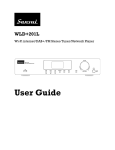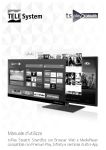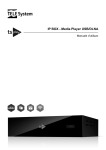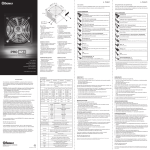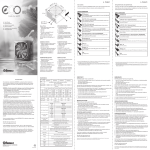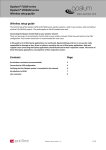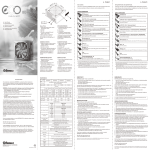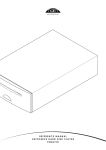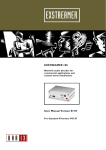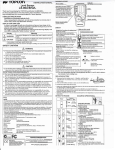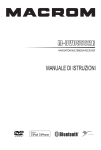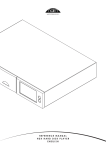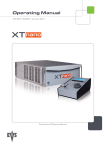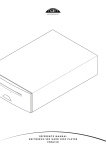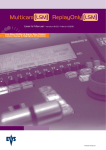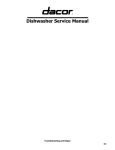Download User Guide - Altronics
Transcript
A 2696 Digital (DAB+) Inter net FM Tuner User Guide Dear Valued Customer Thank you for deciding to purchase this product. This instruction manual will give you a general idea of how this device operates, as well as providing you with information on safety procedures and cleaning. In order to maintain this product in good condition, and to ensure it's safe operation, please take a few minutes to read and carefully follow all the safety and operating instructions found in this manual. Please retain this instruction manual for future reference and pass it along with the device if handed over to a third party. Should you have any additional questions regarding the operation or installation of this device, or should any problems arise from its use, then please contact a specialized dealer or our service team for further information. We assume no liability for any damage incurred as a result of improper use resulting from failure to comply with the safety instructions found in this manual. Under such circumstances all claims under warranty will become null & void. We assume no liability for any consequential damage! This product is EMV-certified and complies with all European and National guideline requirements. A declaration of CE conformity has been established for this product. Certification has been documented and entrusted to the manufacturer Table of Contents 1. INTENDED USE........................................................................................................................................................................ 5 EXPLANATION OF SYMBOLS......................................................................................................................................................................................................... 5 2. SAFETY INFORMATION............................................................................................................................................................. 6 3. ACCESSORIES........................................................................................................................................................................... 7 4. DESCRIPTION OF PARTS.......................................................................................................................................................... 8 F RONT P ANEL..................................................................................................................................................................................................... 8 R EMOTE C ONTROL H ANDSET............................................................................................................................................................................. 9 R EAR P ANEL....................................................................................................................................................................................................... 10 5. CONNECTION........................................................................................................................................................................... 12 P OWER SUPPLY................................................................................................................................................................................................. R ADIO A ERIALS................................................................................................................................................................................................ E THERNET N ETWORK C ONNECTION............................................................................................................................................................... W IRELESS LAN ............................................................................................................................................................................................... 6. BEFORE GETTING STARTED................................................................................................................................................. 13 S CREENS.......................................................................................................................................................................................................... M ENUS.............................................................................................................................................................................................................. M ODES & MENUS OVERVIEW MAP..................................................................................................................................................................... 7. 16 17 17 18 20 21 INTERNET RADIO MODE......................................................................................................................................................... 22 L AST LISTENED................................................................................................................................................................................................. P RESETS........................................................................................................................................................................................................... F AVOURITES..................................................................................................................................................................................................... B ROWSE............................................................................................................................................................................................................ S EARCH............................................................................................................................................................................................................ N OW PLAYING INFORMATION............................................................................................................................................................................ I NTERNET RADIO PORTAL REGISTRATION......................................................................................................................................................... M Y ADDED STATIONS......................................................................................................................................................................................... 9. 13 14 15 GETTING STARTED................................................................................................................................................................. 16 S ETUP WIZARD.................................................................................................................................................................................................. M ANUAL SET...................................................................................................................................................................................................... N ETWORK......................................................................................................................................................................................................... C OMPLETION.................................................................................................................................................................................................... S ETTING UP A MUSIC SERVER........................................................................................................................................................................... S ETTING UP THE A 2696 FOR “ P LAY T O” W INDOWS 7 STREAMING MEDIA FEATURE................................................................................... 8. 12 12 12 12 22 23 23 24 25 25 26 26 MUSIC PLAYER MODE............................................................................................................................................................ 27 S HARED MEDIA (FROM UP N P MEDIA SERVER)................................................................................................................................................ 27 USB PLAYBACK................................................................................................................................................................................................ 28 V IEWING TRACK METADATA.............................................................................................................................................................................. 28 P LAYLISTS......................................................................................................................................................................................................... 29 R EPEAT / SHUFFLE............................................................................................................................................................................................. 29 N OW PLAYING INFORMATION............................................................................................................................................................................ 29 10. USING THE “PLAY TO” FEATURE IN WINDOWS 7............................................................................................................... 30 U SE “PLAY T O” IN W INDOWS M EDIA P LAYER................................................................................................................................................... U SE “PLAY T O” ELSEWHERE IN W INDOWS 7 .................................................................................................................................................... N OW PLAYING INFORMATION............................................................................................................................................................................ 11. 30 30 31 USING THE A 2696 WITH AN APPLE MACINTOSH COMPUTER.......................................................................................... 31 12. DAB RADIO MODE.................................................................................................................................................................. 32 SCANNING FOR STATIONS.......................................................................................................................................................................................................... SELECTING STATIONS................................................................................................................................................................................................................ PRESETS..................................................................................................................................................................................................................................... NOW PLAYING INFORMATION.................................................................................................................................................................................................... SETTINGS................................................................................................................................................................................................................................... 13. 32 32 32 32 32 FM RADIO MODE..................................................................................................................................................................... 33 SELECTING STATIONS................................................................................................................................................................................................................ 33 NOW PLAYING INFORMATION..................................................................................................................................................................................................... 33 SETTINGS.................................................................................................................................................................................................................................... 33 14. LIBRETTO WIRELESS DEVICE REMOTE CONTROL............................................................................................................ 35 OBTAINING THE WIRELESS DEVICE REMOTE CONTROL APPLICATION............................................................................................................................... SETTING UP THE CONNECTION TO THE A 2696..................................................................................................................................................................... STARTING THE WIRELESS DEVICE REMOTE CONTROL APPLICATION................................................................................................................................ MENU STRUCTURE..................................................................................................................................................................................................................... PLAYING INTERNET RADIO......................................................................................................................................................................................................... PLAYING FROM THE MUSIC PLAYER......................................................................................................................................................................................... PLAYING DAB RADIO................................................................................................................................................................................................................. PLAYING FM RADIO................................................................................................................................................................................................................... PLAYING PRESET RADIO STATIONS........................................................................................................................................................................................... OTHER SETTINGS....................................................................................................................................................................................................................... COMPARISON OF A 2696 UI AND WIRELESS DEVICE REMOTE CONTROL APPLICATION FUNCTIONALITY.................................................................. 15. 35 35 35 37 37 38 39 40 41 42 42 SOFTWARE UPGRADE AND FACTORY RESET..................................................................................................................... 43 SOFTWARE UPGRADE................................................................................................................................................................................................................ 43 FACTORY RESET......................................................................................................................................................................................................................... 43 16. TROUBLESHOOTING AND ERROR MESSAGES................................................................................................................... 44 ERROR MESSAGES...................................................................................................................................................................................................................... 46 17. MAINTENANCE AND HANDLING............................................................................................................................................ 47 TRANSPORTING THE DEVICE................................................................................................................................................................................................... 47 KEEPING THE EXTERNAL CASE CLEAN..................................................................................................................................................................................... 47 CLEANING THE DEVICE.............................................................................................................................................................................................................. 47 18. GLOSSARY................................................................................................................................................................................49 19. SPECIFICATIONS......................................................................................................................................................................49 20. WARRANTY INFORMATION.....................................................................................................................................................50 Before use Please read this instruction manual thoroughly before operating this device and retain it for further reference. Following and heeding all the information found in this instruction manual will maintain this product in good condition and ensure its safe operation. This instruction manual contains information on how to operate and maintain this device. Should a component require maintenance, servicing or repair, then please consult a qualified dealer or service technician. 1. Intended Use This device is an FM/DAB/DAB+ stereo tuner with internet radio. It can be used for internet radio station reception by means of internet access either via a broadband high-speed Ethernet cable or wireless LAN (Wi-Fi). FM & DAB radio reception are also possible with an antenna. Music files stored on a network can also be accessed. Please adhere to all of the safety information and instructions found in this instruction manual. An exclamation mark is intended to inform the user of important information, operation or maintenance instructions, or that special attention is required. This symbol is intended to alert you to the presence of unprotected live parts or components found within the product's enclosure, or of dangerous connections that upon contact may be of sufficient magnitude to constitute a risk of electric shock. Cable intended for such connections should only be connected by qualified personnel or you should only use ready to connect cables. There are no user-serviceable parts found inside the device, therefore the device need never be opened. Page 5 2. Safety Information Keep packaging and protective foil away from children at all times to avoid the danger of suffocation. The following safety and hazard warnings are not only for the protection of your device, but also serve as a protection against potential health hazards. Please take time to read the following instructions carefully. The device should never come into contact with water or moisture. We assume no liability for personal or property damage resulting from the failure to comply with the safety instructions, or from improper operation or handling. Under such circumstances, all claims under warranty will become void. To prevent the risk of fire of electric shock make sure that liquids, such as dripping or splashing water, rain or moisture, do not come in contact with the device and power supply plug. Operate this device in a moderate climate and never expose it to extreme temperatures, such as high humidity. For safety and licensing (CE) reasons any unauthorized modification and/or changes to the device is prohibited and will void the warranty and all warranty claims. Condensation can build up suddenly if the device is brought from a colder area into a warmer area (e.g. when transporting). Should this happen, allow the device to warm up to room temperature first before using. Any persons operating, installing, setting up, or servicing this device must be trained and qualified accordingly, and observe these operating instructions. Care should be taken so that liquids do not come in contact with the interior, this is why containers containing liquids, e.g. buckets, vases or plants should never be placed anywhere near this product, including the power supply plug. This could not only damage the device, but also present a fire hazard. Ensure that the device has been set up correctly by following all the instructions found in the instruction manual This is a protection class ll device. Make sure that the voltage supply of the power outlet used meets the required voltage specifications 230V/~50 Hz. It is imperative to avoid contact with moisture, e.g. never operate in the bathroom. Make sure the device is properly ventilated during operation and never operate it in constricted areas, such as for example in a bookcase or shelf. Never block ventilation openings with magazines, tablecloths, curtains or similar. Power supply cables should be routed so that they are not likely to be walked on, squashed or pinched by items placed upon or against them. Pay particular attention to cords at plugs, power outlets, and at the point at which they exit from the device. Avoid exposing the cable to extreme heat or cold. lgnoring the above mentioned instructions could result in cable damage and present the danger of an electric shock. Make sure the device is placed on a firm and stable surface. Never place any sources of fire on top of or near the device and power supply plug (e.g. lighted candle). Should any obvious damage be seen on the device or on the connection cables, do not contact them in any way. Switch of the corresponding circuit breaker in the power distribution panel first, before carefully unplugging the power plug from the wall outlet. Do not operate the device further! Please contact or take it to a qualified service technician or specialty workshop. Please note that excessive sound pressure created when listening to loud volume levels with earphones or headphones can lead to permanent hearing damage. Please adhere to the additional safety information found in the individual chapters of this instruction manual. In order to completely cut off the power supply to the device, unplug the power plug from the wall outlet. Merely turning the device off with the ON/OFF button is not sufficient. Also make sure that power outlets are easily accessible. When connecting other devices, please refer to the safety and operating instructions found in the literature accompanying the device. Please contact our technical hotline or a service technician for further information, should you be in doubt about device operation, safety or when making connections, or if any questions arise that are not explained within this manual. Always pull on the plug’s grips and never on the cable to remove it from a wall outlet. Unplug the device from the power outlet if not in use for a longer period of time. Contribute to a better environment by using a designated recycling site for the disposal of packaging material. For safety reasons, always unplug the device from the power outlet during thunder storms. Eliminate potential tripping hazards by routing cables in such a way that no one can trip or stumble over them. Never use the device, if the power cable or device is damaged. Page 6 3. Accessories The following accessories are supplied with the system. Please check all these parts are present before proceeding. Please inform your dealer if any part is missing or damaged. 1 x Remote control handset 2 x AAA batteries for the remote control handset 1 x DAB radio antenna cable 1 x screw-in Wi-Fi antenna 1 x stereo left and right Phono to Phono cable for connecting to amplifier Page 7 4. Description of parts Front Panel A 2696 Digital (DAB+) Internet FM Tuner 1 2 3 4 5 6 7 8 9 10 1. USB Port - Connect mass storage media like flash drives or Hard Drives. Not suitable for keyboards, mouse, and some MP3 players not supported. 2. TUNE - / : When operating mode is FM Radio press to auto scan for previous station. When operating mode is Music Player, press to skip to previous track. 3. TUNE + / : When operating mode is FM Radio press to auto scan for next station. When operating mode is Music Player press to skip to next track. 4. INFO / station. : When operating mode is FM Radio or DAB Radio press to see RDS / DLS information on the current When operating mode is Music Player press to play, press again to pause. 5. STR / MONO: When operating in FM Radio mode use this button to switch between mono and stereo reception. NOTE: Some stations may be MONO only FM broadcasts. 6. MODE: Change operating mode. Press to select modes either DAB+ Radio, FM Radio, Internet Radio or Music Player. 7. BACK: Press to go to Previous Menu screen. (This function is available from the Remote Control, but the BACK button is not included) 8. MENU: Press to go to Menu screen. 9. Jogwheel: This acts as a volume control, station selector or Menu function selector. Turn left or right to scroll through menu items. Press to confirm the selection. 10. POWER: Press to switch the unit on or off. Page 8 Remote Control Handset 2 1 3 4 6 5 7 9 11 13 8 10 12 14 16 15 17 18 19 20 21 22 1. STANDBY: Press to turn unit on or off. 2. MODE: Press to select one mode within DAB, FM, Internet radio, Media player, USB. 3. Numbers (1-10): In FM or DAB modes, press and hold the number buttons to save station or frequency to a preset. Or press a button to select a stored station. 4. P: Press to browse preset station list. Use up/down arrow keys to highlight a station in the list, and press ENTER to select your preferred station. 5. SCAN: Press to auto search for stations in FM or DAB+ modes. In DAB mode, the scan function will capture all available stations and keep them in memory to be selected at will, or chosen as favourites in the presets list. 6. : PAUSE – Press to pause playback of track in Media Player mode. Also acts as a menu control. 7. : STOP –End all playback 8. : PLAY - Press to start playback of track in Media Player mode. Also acts as a menu control. 9. MENU: Press to go to menu list. Allows a user to change a range of parameters and control each mode of operation for the A2696. 10. : When play mode is FM, press up to change frequency by 0.05 MHz steps. When in MENU screen, press to go up the list of settings to highlight and change. This cursor can also be used for character input. 11. ENTER – OK or confirm button. 12. : Left move – When in MENU screen, press to go back to PREVIOUS menu screen or cancel an action. This cursor can also be used for character input. 13. : Right move - When in MENU screen, press to go forward to NEXT menu selection screen. This cursor can also be used for character input. 14. : When play mode is media player, press to skip to PREVIOUS track. When operation mode is tuner, press to auto scan for previous stations. 15. : When play mode is media player, press to skip to NEXT track. When play mode is tuner, press to auto scan for next stations. 16. PRESET+: press to go to next preset station. 17. PRESET-: Press to go to previous preset station. 18. : When play mode is FM, press down to change frequency by 0.05 MHz steps. When in MENU screen, press to go down the list of settings to change. This cursor can also be used for character input. 19. INFO: Information about current stations or tracks 20. STEREO: When in FM mode, press to change from mono to stereo reception (works only where station is broadcasting in stereo. Some low-power FM station broadcast in mono only!) 21. MUTE – Press to turn audio volume off and on again. 22. MONO: When in FM mode, cancels STEREO command. Page 9 Rear Panel A 2696 Digital (DAB+) Internet FM Tuner CAUTION DAB/FM 12 RISK OF ELECTRIC SHOCK DO NOT OPEN AC240V DAB/FM 1 2 3 4 5 6 1. Power cord. 2. Optical: Connect an optical cable (not supplied) to connect to a digital input such as the optical input on amplifiers. 3. Signal Output: RCA stereo ANALOGUE output connections. Connect RCA to RCA stereo pair cable (supplied), ensuring the red connector on the cable is connected to the red connector on both the A 2696 and your amplifier. 4. LAN: Ethernet cable connection for connecting between the A 2696 and a router (UTP Cable not supplied). 5. Wi-Fi 2.4G Antenna: WLAN 2.4 GHz Wi-Fi antenna input jack for internet radio (supplied). 6. DAB/FM Antenna: 75 ohm Tuner antenna for both FM and DAB+ radio reception (supplied). DESCRIPTIONS Optical: Use this output to connect a digital amplifier using an optical cable (also known as an optical waveguide or TOSlink). One of the advantages of digital transmission of the audio signal to the amplifier is that interference cannot affect the signal and reduce the quality as can occur with analogue transmission. You can also connect the optical input of a digital recorder to this output to save and then playback the audio. This output uses the S/PDIF (Sony / Philips Digital Interface) protocol. This is a standard protocol for digital transmission of audio signals, which is supported by just about any device with a digital interface. Before making the audio connection to your amplifier, please make sure the volume is at a suitable level to prevent damage to your hardware. Signal Out: The line output on the back of the device is intended to be connected to the Line input of a Hi-Fi amplifier or a pair of active speakers (speakers with built-in amplifiers). The output is designed for a voltage level of 2 VRMS. Before making the audio connection to your amplifier, please make sure the volume is at a suitable level to prevent damage to your hardware. LAN: Use this port if you would like to integrate the A2696 into your network via a wired connection. To distinguish it from the wireless or WLAN connection, it is frequently referred to as a LAN or Ethernet port. The port supports data rates of 10 and 100 Mbps. To connect the A2696 to your router in this manner, use a standard network cable (twisted pair with RJ45 plugs). To connect the A2696 directly to your desktop PC or laptop, either use a network switch (also known as a bridge) or a hub. To connect the A2696 without any intermediate devices, use a crossover cable instead of a standard network cable. Two LEDs near the port show the status of the link: orange indicates a live connection to the network junction (node); network traffic is signalled by a green LED (usually flickering). Wi-Fi 2.4 GHz WLAN Antenna: If you have access to a 2.4 GHz Wireless LAN (WLAN) router, screw the antenna provided onto this connector. If possible, ensure that the antenna is set to a vertical position to ensure the best possible reception. Page 10 Always follow the manufacturer’s instructions when recharging rechargeable batteries. Dear Customer! Touching leaking or damaged batteries could cause skin burns. Use protective gloves suitable for handling such batteries. Note: Do not throw batteries and rechargeable batteries into household waste! Always ensure that the device has been turned off after use. Consumers are legally obligated to return used and rechargeable batteries, whether they contain harmful substances* or not, to designated recycling areas, disposal sites, or stores where batteries/ rechargeable batteries can be bought. By doing so, you are fulfilling all legal battery recycling and disposal obligations and are contributing to a better enviroment. Make sure batteries are completly discharged before disposing! Always change/replace all batteries at the same time. If required clean battery and device contacts before inserting. *) marked with Cd=cadmium Hg=mercuric Pb=lead Inserting/changing batteries The remote control requires two “AAA” batteries to operate. Remove the battery compartment lid carefully. Remove the used batteries. Insert new batteries, observing the correct polarity as displayed inside the remote. Replace the battery lid carefully. Information on handling batteries and rechargeable batteries Please adhere to the following information when handling batteries and rechargeable batteries. Keep batteries out of children’s reach. Batteries are hazardous and do not belong in household waste. Ensure correct polarity when inserting batteries. Always remove batteries when the remote control is not in use for long periods of time. Never leave batteries lying around unsupervised. If swallowed these could pose a choking hazard to children and pets. Seek emergency medical care immediately, should this happen. Never expose batteries to extreme temperatures, such as sunlight, fire, ovens, etc. There is a risk of explosion! Make sure that batteries are not dismantled, short-circuited or are thrown into fire. Never re-charge nonrechargeable batteries. There is a risk of explosion! Page 11 5. Connection Power supply Ethernet Network Connection Plug the power cable into a correctly installed power outlet of your home power system. For best results when receiving internet radio stations or playing music files from your network, use an Ethernet cable (not supplied) to connect to a spare Ethernet port on your router. Radio Aerials Wireless LAN In order to receive DAB or FM radio broadcasts it is necessary to connect the supplied wire aerial to the screw socket marked DAB/FM Antenna. Alternatively, if you have an external aerial, you can connect a suitable cable from the socket marked DAB/FM Antenna to a wall socket that connects to the roof aerial. For wireless operation, attach the antenna to the “Wi-Fi 2.4G Antenna” connection. This screws in clockwise. A 2696 Digital (DAB+) Internet FM Tuner CAUTION DAB/FM 12 RISK OF ELECTRIC SHOCK DO NOT OPEN AC240V DAB/FM Optical cable Wi-fi aerial Page 12 6. Before Getting Started Screens The screen shows various menus, dialogues and displays, as described below. There are basically six types of screen: . Standby . Splash / temporary (e.g. changing modes) . Now playing . Dialogue . Error/Information . Menu When text is too long to fit on the screen, it is first shown truncated, then, after a few seconds, slowly scrolls so that you can read it all. The Standby screen shows the time, date and any active alarm times. As you cycle through the play modes by pressing the Mode button the A 2696 shows a splash screen for each mode. After one second, the A 2696 enters the selected mode and tries to start playing the last station or track that was playing in that mode. If this is not possible, the A 2696 tries to connect to the selected source by scanning for stations, networks, or prompting for user input as appropriate. Now playing screens show information about the audio source and track now playing, where available. Dialogue screens are shown to allow the user to change settings. They vary in complexity from simple Yes/No options up to the scrollable network password input screen. As with menus, the selected item is shown with a white background. Dialogue screens mark the current setting with an asterisk (*). Error/Information screens give specific messages for a few seconds, then change automatically to another screen. Page 13 Menus The A 2696 has basically three types of menu. Use the Select control to step through and select options. A scroll bar on the right of the screen shows if there are further options above or below those visible. Each mode has a Mode menu, with options specific to that mode. For example, the FM mode menu has just two options: Scan setting and Audio setting. In addition, each mode menu has two final options: System settings > and Main menu >. The '>' indicates options leading to further menus. The System settings menu allows access to system settings and information such as network, time, language and software update. Menus with more options than will fit on one screen have a scroll bar to the right. The Main menu allows access to all modes plus sleep and timer functions. The Main menu allows access to all modes plus sleep and timer functions. Some menus, for example the System settings menu, have several submenus. See the Modes and menu overview map on page 15. Page 14 Page 15 7. Getting Started Although the A 2696 is sophisticated, getting started is simple. After connecting your system to the speakers, to play DAB or FM radio, all you need is a power source (a 220~240 V mains supply). For Music Player mode, you need either a USB stick containing compatible music files or a wired or wireless Ethernet network and a UPnP music server (e.g. a PC or a network attached storage (NAS) drive containing your music library). For Internet-connected modes such as Internet radio you also need a broadband Internet connection. Setup wizard When the A 2696 is started for the first time, it runs through a setup wizard to configure settings for date/time and network. Once this has finished, the system is ready to use in most modes. Note: To change these settings later, select Menu > System settings >. To run the setup wizard again, select Menu > System settings > Setup wizard. Select Yes to start the setup wizard. If you choose No, the next screen asks if you would like to run the wizard next time The A 2696 is started. The system then starts without configuring time/date and network settings and enters the Main Menu. Note: If power is removed while the wizard is in progress, the wizard will run again next time the A 2696 is started. 12/24 hour display To change between 12 and 24 hour display, select Set 12/24 hour and then select your preference. Time/date The time and date can be updated manually or automatically. With auto-update, the time and date are automatically synchronised with external clocks. Auto-update is generally more accurate. Auto-update Auto-update works with data sent over DAB, FM or the Internet. The clock is only updated when in a corresponding mode, so it is best to select a mode you use regularly. DAB and FM use time signals broadcast with radio transmissions. Network uses a time signal sent from the vTuner Internet radio portal when in any network connected mode. Select Update from DAB, Update from FM, Update from Network or No update. If you are updating from the network, set your time zone. If your country uses daylight saving, the automatically updated time from the network may be wrong by one hour. When daylight savings are in effect (during the winter), turn on the Daylight savings option to rectify this. Note that if you are updating the time from DAB or FM, the Daylight savings option has no effect on the clock's time. The A 2696 will auto-update from the selected source when time information is available. Page 16 Manual set If you set No update, the wizard now prompts you to set the time and date manually. The date and time are displayed as dd-mm-yyyy and hh:mm AM/PM with the first value, dd, active (flashing). Adjust each value with the Select control. As each value is set, the next value becomes active and flashes. Network The A 2696 is compatible with all common network protocols and encryption methods, including Wi-Fi Protected Setup (WPS). To connect the A 2696 to your network, you need one of the following: A wired router and an Ethernet (RJ45 network) cable A Wi-Fi wireless router, together with password key if set Select WLAN region/country (for the UK choose Most of Europe) > Wi-Fi network (SSID), and then select a network from the list. To connect to a wired network, select [Wired], after ensuring that the Ethernet cable from the wired router is connected to the Ethernet socket of the A 2696. If the network is open (nonencrypted), A 2696 connects immediately (see Completion below). Standard encrypted network To enter the network's key (password), use the Select control to move the cursor through the characters and press Select. As each character is selected, the key is built up near the top of the display. There are three options accessible by turning Select back before the first characters (0123…) – Backspace, OK and Cancel. WPS encrypted network WPS encrypted networks are identified by '[WPS]' at the start of the network name, and have three methods of connection. Select one and follow the prompts: Push Button > The A 2696 prompts you to press the connect button on the router. It then scans for a ready Push Button Connect network and connects. Pin > (code number) The A 2696 generates an 8-digit code number which you enter into the wireless router, access point, or an external registrar (e.g. advanced versions of Windows Vista). Skip WPS > Enter key as for a standard encrypted network, above. For more information on setting up a WPS encrypted network, see your WPS router's instructions. Page 17 Completion The A 2696 attempts to connect to the selected network. If connecting fails, the A 2696 returns to a previous screen to try again. If the network connection is lost, the A 2696 will automatically attempt to reconnect. If network connection is successful the Connected screen will appear. Upon completion of the process the Setup Wizard confirms connection and setup up has been successful Page 18 Network The A 2696 remembers the last four wireless networks it has connected to, and automatically tries to connect to whichever one of them it can find. You can see the list of registered networks through Menu > System settings > Network > Network profile >. From here you can delete unwanted networks by turning and pressing Select then confirming delete Yes. There are also other options for viewing and manually altering network settings from Menu > System settings > Network > (for example setting up a wired network). Users experienced with networking may find these options useful for diagnosing and fixing network problems. Language The default language is English. To change, select Menu > System settings >Language > then select your language. Page 19 Setting up a music server In order for the A 2696 to play music files from a computer, the computer must be set up to share files or media. UPnP media sharing allows devices like the A 2696 to play music from a shared media library, navigating through tag menus such as Artist, Album or Genre. If you are running a suitable server system such as a PC with Windows Media Player 10 or later (WMP), and your music library is well-tagged, then it is recommended to use media sharing. Only the UPnP server needs to be set up. Note: iTunes does not currently work as a UPnP media server, but there are add-ons available (such as Allegro Media Server™ for Macintosh or PC) to work with an iTunes library. Alternatively if you are a PC user simply install and run Windows Media Player (10 or later) and add your iTunes library to the media library in Windows Media Player. You will be able to continue to use iTunes as your primary source of music library management and Windows Media Player will update automatically making your music always available on the A 2696. Sharing media with Windows Media Player The most common UPnP server is Windows Media Player (10 or later). Alternatively, other UPnP platforms and servers may be used. To set up WMP for media sharing, perform the following steps: 1. Ensure that the PC is connected to the network. 2. Ensure that the A 2696 is powered on and connected to the same network. 3. In WMP, add to the media library the audio files and folders you want to share with The A 2696 (Library > Add to Library…). 4. In WMP, enable media sharing by right clicking on the Library and then selecting Media sharing…) 5. In the next dialogue box you'll see the A 2696 displayed. Click on the icon representing the A 2696 and then click Allow Your newly shared media library will now be listed under Music Player > Shared Media on the A 2696 Note: The WMP UPnP service runs in the background; there is no need to start WMP explicitly each time. Opus One Page 20 Setting up the A 2696 for “Play To” Windows 7 streaming media feature. To set-up the A 2696 to be controlled and to stream music via Windows Media Player 12 (Windows 7 only), perform the following steps: 1. Ensure that the PC is connected to the network. 2. Ensure that the A 2696 is powered on and connected to the same network. Note: the A 2696 must be in Internet Radio mode to be detected. 3. From the Windows 7 main screen, select Start > Devices and Printers. 4. Select the Add a device tab in the top left of the Devices and Printers window and follow the instruction prompts given by the wizard. 5. In the Devices and Printers window a A 2696 icon will appear and you are now ready to stream your Windows media music files to the A 2696 6. In order to use the Windows 7 Play To feature you will have to enable Media Sharing within Windows 7's network settings. For a full explanation please visit http://windows.microsoft.com/en GB/windows7/products/features/play-to Opus One A 2696 Page 21 8. Internet radio mode The A 2696 can play thousands of radio stations and podcasts from around the world though a broadband Internet connection. When you select Internet radio mode, the A 2696 contacts the Frontier Silicon Internet radio portal to get a list of stations, organised into different categories like Country, Most popular and Genre. Once you select a station, the A 2696 connects directly to that station. The portal also enables multiple lists of favourite stations that you can personalise, for example Andy's stations, Jo's favourites, Talkshows, etc. To use the favourites feature, register your radio with the portal website as described on page 26. If you have several of these radios, you can register them all on the same account so that each radio has access to the same favourites lists. It is possible to add favourites either directly through the A 2696 or through any computer with a web browser. To enter Internet Radio mode, either press Mode until the display shows Internet Radio or select Menu > Main menu > Internet Radio. Note: The station list menu is provided from the Internet radio portal, so it is only accessible when the A 2696 is connected to the Internet. Station lists and submenus may change from time to time. There are several ways of selecting stations. Directly from the radio: . Last listened . Pre-sets Or from the portal through the Menu > Station list > menu: . Favourites lists . Browse by Country, Genre, Most popular, Newest . Search by keyword . My added stations If you are already listening to an Internet radio station, you can press Back rather than Menu to quickly return to the last visited branch of the menu tree. For example, suppose you were listening to New Orleans Radio through the browse facility as described in section 4.4 below. Pressing Back would return you to the Highlighted Blues stations menu. Pressing Back again would return you to the Blues menu, and so on. Last listened When Internet radio mode restarts, the last-listened station is selected. To select another recently used station, select Menu > Last listened then one of the stations listed. Most recent stations appear at the top of the list. Page 22 Presets Presets are stored in the radio and cannot be accessed from other radios. To store an Internet radio preset, press and hold the P button on the remote control handset until the display shows the Save to Preset screen. Using the down or up keys on the remote, select one of the 10 presets and press the Enter button on the remote control handset to store the currently playing station. To select a preset, press P button briefly, then select one of the listed preset stations. When a preset station is playing, it shows Pn (P1, P2 etc) in the bottom of the screen. Note: Operation of presets is identical for Internet radio, DAB and FM. Also press and hold (1-10) button can save station to preset number. Selecting a preset station There are different ways of selecting a preset station. Press a numeric button (1 – 10) on the remote control handset to select the memory presets 1-10. Press “P” to display a list of stored stations. Use the ▲ and ▼ buttons or turn the “CONTROL” dial to select the preferred station. Press the “ENTER” button or the “CONTROL” dial to confirm and switch to the selected station. Press “t”, “P” or “BACK” to exit this menu. The menu will close automatically after a while. Favourites Favourites are different from Presets in that they can be stored on the internet radio portal directly, not just on the A 2696. Before you set up an account on the portal from its web interface (www.wifiradio-frontier.com), the favourites are associated solely with A 2696. After you set up a portal account, all the Favourites from your different radios are merged into a combined favourites list. This combined list is available to all the radios on your account. (see page 26 for details of how to register your A 2696 on the internet radio portal) To store a playing station as a Favourite, press and hold Select until the display shows 'Favourite added'. The station appears in the default Favourites list Stations. To select a favourite, select Menu > Station list > My favourites >[Favourites list] > [Station]. Page 23 Browse To browse Internet broadcasts, select Menu >Station list > then either Stations > or Podcasts >. Browse through the menus to find broadcasts. Note: BBC radio 'Listen Again' programs are accessible through the Podcast menu, for example Menu > Podcasts > Location > Europe > United Kingdom > All shows >BBC Radio 4 > You and Yours > 20/10/2011 - October 20. Page 24 Search You can also search through Internet broadcasts for stations or podcasts with particular keywords in their title. To search, select Menu > Station list > then either Stations > or Podcasts > Enter a keyword by selecting characters then OK. The search entry screens are similar in operation to the Wi-Fi password entry screen. Select a broadcast from the list. For podcasts, you may be able to select a particular episode. Now playing information While the stream is playing, the screen shows its name and description. If artist and track information is available, this is also shown. To view further information, press Info. Each time you press Info, another set of information is displayed. Cycling through the following details: Artist and track name (default; where available) Station description Station genre and location Signal reliability Codec and sampling rate Playback buffer Today's Date Page 25 Internet radio portal registration The Frontier Silicon Internet radio portal website allows you to organise the 'favourites' lists displayed on your internet radio devices and also listen to internet radio directly from a computer. To register your A 2696 with the portal, switch to Internet radio mode as described in Section 4, and then obtain your radio's unique portal access code by selecting Menu > Station list > Help >Get access code >. Write down the access code. Note: Do not confuse the portal access code with the Radio ID (from Menu >System settings > Info.) Visit the portal website at www.wifiradio-frontier.com. If this is your first visit to the portal, click register here below login boxes to register for a new account. You'll be asked for the following information: access code your e-mail address password radio model (A 2696) If you already have an account and wish to add the A 2696 , log in to your account and select My preferences > Add another Wi-Fi radio. Once your A 2696 is registered with the portal, you can immediately use the Internet radio favourites and added stations features on the unit. My added stations Using the internet radio portal you can add your own stations via the portal. These added stations are accessible from the A 2696 by selecting Menu > Station list > My added stations > [Station]. Page 26 9. Music player mode (network and USB) Music Player mode plays a variety of audio file formats such as MP3, AAC (Apple), WMA (Microsoft) as well as the completely lossless formats WAV & FLAC. These can be 'streamed' from a computer on the local network, or from a USB Flash stick or a hard drive on the network, known as a NAS drive (Network attached storage). To enter Music Player mode, either press Mode until the display shows Music player, or select Menu > Main menu > Music player. Once in Music Player mode, press Menu , then select either Shared media or USB playback. If you are already playing a music file, you can press Back rather than Menu to quickly return to the last visited branch of the menu tree. For example, suppose you were listening to the track Heat by the artist 50 Cent through browsing shared media as described in section 5.1 below. Pressing Back would return you to the track listing for the album Get Rich or Die Tryin'. Pressing Back again would list all 50 Cent albums. Pressing Back again would list all album artists, and so on. You can use and on the remote or on the A 2696 itself to move through tracks. Press and hold to rewind or fast forward and press quickly to select previous or next track. Shared media (from UPnP media server) Select Menu > Shared media > If you have set up a music server (as described on page 20), you should see an entry consisting of <computer name>: <Shared media name>, for example JB-Laptop: Audio If you have more than one computer sharing media, the alternatives are listed. Select the shared media you want to play. From this point on, the menus are generated from the shared media server (typically Windows Media Player). The first menu shows a list of media types, for example Music, Video, Pictures and Playlists. The A 2696 can only play music and playlists. There is also a search function, which finds tracks in a similar way to Internet radio search. (as described on page 25.) From Music, there are numerous ways of selecting tracks, including: . Genre . All Artists . Contributing Artists . Album Artists . Composers . Album . Rating Once you have found a track you want to play, press Select . A short press plays the track immediately and a long press adds the track to the playlist. You can also add entire albums to the playlist. The A 2696 plays either the selected track or the playlist. Page 27 Wake-on-LAN If shared media is selected, a list of available music servers will be displayed. If a question mark appears before the server name, this indicates that the server has been seen before and supports Wake-on-LAN functionality, but cannot currently be found on the network. If a server with a question mark is selected by the user, the device will try to wake the server up and connect to it. In some instances this may not be possible as the server may not be connected to the network any more or may be switched off. Prune servers From time to time it may be necessary to remove servers displaying question marks in front of the server name from the server list. For example, if the device is moved to a new network or if a Wake-on-LAN server is removed from your current network. To perform this function, go to Menu > Prune servers > Yes USB playback To play audio from a USB mass-storage device such as a USB Flash stick or USB hard drive, Select Menu > USB playback. Browsing folders From this point on, menus are generated from the folders on the USB device. Browse folders with the Select control and Back button. The display shows folder and file names (not necessarily track names). Once you have found a track that you want to play, press Select. A short press plays the track immediately and a long press adds the track to the playlist. You can also add entire folders to the playlist. The A 2696 plays either the selected track or the playlist. Viewing track metadata While a track is playing, you can view extra information about it (called metadata) by pressin Info. Each time you press Info, a different item of metadata is displayed. See Now Playing section on page 29 for descriptions of the metadata for UPnP and USB. Page 28 Playlists The A 2696 holds a queue of up to 500 tracks in the playlist. Playlist tracks can be mixed from multiple UPnP servers and USB. To manage the playlist, select Menu > My playlist. To view the playlist, scroll though it by turning Select. UPnP tracks show their track name; USB tracks show their file name. To play the playlist from a certain track, scroll through the playlist to the track you want and quickly press Select. To erase a track from the playlist, press and hold Select then confirm 'YES' by pressing Select. If you select a track/album/folder for instant playback (without using the playlist), the playlist is preserved. The playlist is also preserved during standby. Repeat/shuffle You can repeat tracks or play them in random order by selecting Menu > Repeat play or Menu > Shuffle play Now playing information While a track is playing, the screen shows its track and artist (UPnP) or file name (USB). There is also a progress bar with figures for elapsed and total track time. At the bottom of the screen, an icon indicates UPnP or USB depending on the source. To view further information, press Info. Each time you press Info, another set of information is displayed, cycling through: UPnP playback: progress bar (default), album, codec/sampling rate, playback buffer bar, today's date USB playback: progress bar (default), artist, album, folder, full file path, bi rate/codec type/sampling rate, playback buffer bar, today's date Page 29 10. Using the “Play To” feature in Windows 7 Windows 7 includes a feature called “Play To” and this lets your PC running Windows 7 control the A 2696 to push media and use the PC as a universal remote control for your media collection. The A 2696 supports the industry standard DLNA (Digital Living Network Alliance) 1.5 digital media renderer. This allows you to "Play To" other devices around your home and combine media streaming with controlling a connected media receiver while streaming content to it from another Windows 7 PC on a home network. Before you can use the “Play To” feature you need the set-up the A 2696 for Windows 7 streaming media. See page 20. Use “Play To” in Windows Media Player Windows Media Player makes it easy to manage your media, find items that you want to play, and open Play To. To select items that you want to play, follow these steps: 1. Click the Start button, click All Programs, and then click Windows Media Player. If the Player is currently open and you're in Now Playing mode, click the Switch to Library button in the upper-right corner of the Player. 2. If the list pane is closed or if the Burn or Sync tabs are exposed, click the Play tab. 3. Find the items that you want to play in the Player Library, and then drag those items from the details pane into the list pane. 4. Click the Play to button at the top of the list pane, click the device on your network that will receive the media. 5. In the Play To dialog box, use the playback controls to play, pause, or stop the media stream, and to change to the next or previous item in the list. Opus One A 2696 Opus One A 2696 Use “Play To” elsewhere in Windows 7 Outside of Windows Media Player, you can stream media to the A 2696 with “Play To” by right-clicking music files. To select music files and stream them to the A 2696, follow these steps: 1. Click the files you want to stream to the A 2696. 2. Right-click the selected files, point to “Play to”, and then click the device on the network that will receive the media. 3. In the Play To dialog box, use the playback controls to play, pause, or stop the media stream, and to change to the next or previous item in the list. Opus One A 2696 Opus One A 2696 Page 30 Now playing information While a track is playing, the screen shows its track name (UPnP). There is also a progress bar with figures for elapsed and total track time. At the bottom of the screen, an icon indicates UPnP. To view further information, press Info. Each time you press Info, another set of information is displayed, cycling through the following: Artist, album, codec/sampling rate, playback buffer 11. Using the A 2696 with an Apple Macintosh computer Because of the different system protocols used in computing it's not always possible to make every connected product instantly compatible with all computer technology. The network system protocol used on the A 2696 is called DLNA (Digital Living Network Alliance) which is a system designed to give the user more convenience, choices and enjoyment of digital content through DLNA Certified® devices. (see www.dlna.org for more details) Because Apple products are not automatically DLNA compatible it is necessary to install a software program to enable a DLNA device such as the A 2696 to see it and any music files stored on it, across the network. There are many such programs available. One such free application is called TV Mobili and can be downloaded from http://www.tvmobili.com/ Another is Serviio Media Server http://www.serviio.org/ There are many others. For more information talk to your local Apple reseller. Page 31 12. DAB radio mode DAB radio mode receives DAB/DAB+ digital radio and displays information about the station, stream and track playing. To enter DAB mode, either press Mode until the display shows DAB Radio or select Menu > Main menu > DAB. Scanning for stations The first time you select DAB radio mode, or if the station list is empty, the A 2696 automatically performs a full scan to see what stations are available. You may also need to start a scan manually to update the list of stations for one of the following reasons: Available stations change from time to time. If reception was not good for the original scan (for example the antenna was not up), this may result in an empty or incomplete list of available stations. If you have poor reception of some stations (burbling), you may wish to list only stations with good signal strength. To start a scan manually, select Menu > Scan. Once the scan is complete, the radio shows a list of available stations. To remove stations that are listed but unavailable, select Menu > Prune invalid. Selecting stations To listen to or change a station, turn the Select control to view a list of stations and press to select. Once selected, the station plays and the screen shows information about the station, track or show as broadcast. Presets To store a DAB preset, press and hold P on the remote handset until the display shows the Save preset screen. Select one of the 10 presets to save the currently playing station. Press Enter on the remote to store. To select a preset, press P on the remote control handset briefly, then select one of the listed preset stations with the up or down arrow keys. When a preset station is playing, it shows Pn (P1, P2 etc) in the bottom right of the screen. Now playing information While the stream is playing, the screen shows its name and DLS (Dynamic Label Segment) information broadcast by the station giving real-time information such as program name, track title and contact details. Stereo broadcasts are indicated with an icon at the top of the screen. To view further information, press Info. Each time you press Info, another set of information is displayed, cycling through DLS text, program type, ensemble name/frequency, signal strength/error rate,bit rate/codec/channels and today's date. Settings Dynamic range compression Some DAB broadcasts offer dynamic range compression (DRC). This feature allows radios to compress the dynamic range of the output audio stream, so that the volume of quiet sounds is increased, and the volume of loud sounds is reduced. This can be useful if you are listening to music with a Page 32 high dynamic range in a noisy environment (for example, classical music while cooking). To change the DRC of the A 2696, select Menu > DRC, and then DRC high, DRC low or DRC off. Note: The A 2696's DRC setting does have any effect if DRC data is not included in the broadcast. Station order You can choose the order of the DAB station list to be either Alphanumeric, Ensemble or Valid. Ensemble lists groups of stations that are broadcast together on the same ensemble, for example BBC or South Wales local. Valid lists valid stations first, alphanumerically, then off-air stations. To change station order, select Menu > Station order > then Alphanumeric, Ensemble or Valid. 13. FM radio mode FM radio mode receives analogue radio from the FM band and displays RDS (Radio Data System) information about the station and show (where broadcast). To enter FM mode, either press Mode until the display shows FM Radio or select Menu > Main menu > FM. Selecting stations To find a station, press Select . The frequency display starts to run up as the A 2696 scans the FM band. Alternatively, you can scan up or down by pressing and holding the and buttons or tune manually with quick presses, or by turning the Select control. To store an FM preset, press and hold P on the remote handset until the display shows the Save preset screen. Select one of the 10 presets to save the currently playing station. Press Enter on the remote to store. To select a preset, press P on the remote control handset briefly, then select one of the listed preset stations with the up or down arrow keys. When a preset station is playing, it shows Pn (P1, P2 etc) in the bottom right of the screen. Now playing information While an FM station is playing, the screen shows one of the two following sets data: If RDS information is available, by default the service name (i.e. station name) is displayed. You can cycle through further RDS information by pressing Info Each time you press Info, another set of information is displayed, cycling through RDS radio text, RDS program type, frequency and today's date. If no RDS information is available, the currently tuned frequency is shown. Settings Scan settings By default, FM scans stop at any available station. This may result in a poor signal-to-noise ratio (hiss) from weak stations. To change the scan settings to stop only at stations with good signal strength, select Menu > Scan setting > Strong stations only? > Yes. Page 33 Audio settings By default, all stereo stations are reproduced in stereo. For weak stations, this may result in a poor signal-to noise ratio (hiss). To play weak stations in mono, select Menu > Audio setting > FM weak reception: Listen in mono only > Yes. Page 34 14. Libretto Wireless Device Remote Control Libretto Wireless Device Remote Control is an application for the iPhone and the iPod touch, that allows users to control the A 2696 devices. Using the Libretto application, you can navigate between the A 2696's music modes, and browse and play content remotely. The Libretto application works on all iPhones and iPod touch devices running iOS 3.1.3 or later. It works with the IR2.2 software running on the A 2696. Note: For brevity, “iPhone” is used to mean “iPhone or iPod touch” in this chapter. Please note the volume control on the app will not affect the volume when used with any stand-alone network player. Obtaining the Wireless Device Remote Control application To install the Wireless Device Remote Control application on the iPhone: 1. In the iPhone's main menu, open the App Store by clicking the App Store icon. 2. In the App Store, search for “DOK”: 3. Select Frontier Silicon Ltd DOK The application is free so you can just choose to install it with no charge to your iTunes account. Setting up the connection to the A 2696 After you download the Libretto Wireless Device Remote Control application, you must set up a connection between the iPhone/iPod and the A 2696. To do this, follow these steps: 1. On the A 2696, navigate to Menu > Main menu > System settings > Network > Keep network connected, and select YES. The network connection now stays on when the device is in standby mode. This setting is retained in the device's memory after it is switched off and on again. 2. Make sure your iPhone is connected to the same wireless network as the A 2696 Starting the Wireless Device Remote Control application To start the Libretto Wireless Device Remote Control application: 1. Tap the Libretto icon on the main menu of the iPhone. The Libretto application starts. You will be asked to enter a PIN number. The PIN is 1234. Enter this on the screen. 2. A splash screen opens. If any radios are found on the same network, the Radio screen opens. Page 35 3. Select the Opus One A 2696 from the Radio list. (You can only control one radio at a time.) Opus One A 2696 4. The Mode screen opens, showing the listening modes that are available on the A 2696 Main menu The main menu of the Libretto Wireless Device Remote Control application is visible at the bottom of the screen from most screens: The main menu contains icons that link to the main screens of the application: Browse Allows you to browse content for the currently selected mode. Mode Allows you to browse and switch between listening modes (Internet radio, Music player, DAB, FM) Preset In Internet Radio, DAB and FM modes, allows you to select a preset station. Audio EQ Allows you to select an equalisation setting, or to adjust a custom equalisation setting Settings Allows you to change the settings of the Wireless Device Remote Control application The main menu is not accessible from the “Now Playing” screens. Page 36 Menu structure The menu structure of the Libretto Wireless Device Remote Control application mirrors that of the EUI 2.2 software running on the A 2696. The Mode menu of the Libretto Wireless Device Remote Control application corresponds to the Main menu of the A 2696 screen. For complete descriptions of the menus for each listening mode, please refer to the relevant chapter describing the A 2696 screens in this document. Not all of the functions accessible from EUI are available in the Libretto Wireless Device Remote Control application. Meanwhile, some functions are available in the Libretto Wireless Device Remote Control application that are not available from the UI, such as quick browsing of network or USB content, and display of album artwork. Playing Internet radio To play the current Internet radio station Select Mode > Internet radio. Opus One A 2696 The last played Internet radio station plays: If no Internet radio station is currently selected, the Browse screen opens (see opposite). To change the volume of playback: Move the volume slider. To mute or unmute playback: Tap the Mute icon to the left of the volume slider. To browse Internet radio stations: In Internet radio mode, select the back button to go to the Browse screen. Browse through the menus. The menu structure is the same as that in the A 2696 UI (see page 15) When you find a station that you want to listen to, tap it in the list. The radio station plays. Page 37 Playing from the Music player To play files from a computer network or a USB device: Select Mode > Music player. The Music player Browse screen opens at the top level: Navigate through the directory structures of the connected devices, until you find the track that you want to play. Select the track that you want to play. A “Now playing” screen opens, and the selected track plays. Opus One A 2696 Details of the track are displayed on the screen, along with album art, if this is available. After the track finishes playing, the music player plays the track that follows it in the same directory. If desired, control playback by tapping the screen as follows: Tap here: To do this: Jump to a point in the currently playing track Jump to the next and previous tracks Pause the Music player Page 38 Playing DAB radio To play the current DAB radio station: Select Mode > DAB. The last played DAB radio station plays: Opus One A 2696 If no DAB radio station is currently selected, the Browse screen opens (see opposite). To scan for the previous or next DAB radio station: In the DAB “now playing” screen, tap or respectively. To mute or unmute playback: Tap the Mute icon to the left of the volume slider. To browse DAB radio stations: In DAB radio mode, select Browse from the main menu. From the list, select the station that you want to listen to and tap it to listen. Page 39 Playing FM radio Opus One A 2696 To play the current FM radio station: Select Mode > FM. The last played FM radio station plays: If no FM radio station is currently selected, the Browse screen opens (see opposite). To scan for the previous or next FM radio station: In the FM“now playing” screen, tap respectively. To mute or unmute playback: Tap the Mute icon to the left of the volume slider. To browse FM radio stations: In FM radio mode, select Browse from the main menu. From the list, select the station that you want to listen to and tap it to listen. Page 40 Playing preset radio stations The Preset menu option displays a list of preset radio stations that you can select to listen to in Internet radio, DAB or FM modes. Only presets for the currently selected mode are listed. To play a preset radio station: Select Mode > Preset. Select a station from the list. The station plays. Page 41 Other settings The Settings menu provides general settings for the Libretto Wireless Device Remote Control application. From this menu, you can select the following options: Option Function Radio Scans for radios in range Disable Auto-Lock Stops the device locking Power Switches the A 2696 off or on About Shows the version and details of the application Comparison of A 2696 UI and Wireless Device Remote Control application functionality Page 42 15. Software upgrade and factory reset Software upgrade From time to time, We may make software upgrades available with upgrades and/or additional features. You can either check manually, or set A 2696 to check periodically automatically (this is the default). If the A 2696 detects that newer software is available, it asks if you want to go ahead with an update. If you agree, the new software is then downloaded and installed. After a software upgrade, all user settings are maintained. CAUTION: Before starting a software upgrade, ensure that the A 2696 is plugged into a stable mains power connection. Disconnecting power during a software update may permanently damage the unit. To turn automatic checking on or off, select Menu > System settings > Software update > Auto-check setting. Factory reset A factory reset resets all user settings to default values, so time/date, network configuration and presets are lost. However, the radio's current software version is maintained, as is registration with the Internet radio portal. Internet radio favourites therefore remain unless you re-register your radio with another account on the portal website. To perform a factory reset, select Menu > System settings > Factory reset Proceed > Yes. Page 43 16. Troubleshooting and error messages The A 2696 is equipped with state-of-the-art technology and is safe to operate. Nevertheless, problems or malfunctions may occur. Before contacting our customer support, refer to the following for possible solutions. PROBLEM No power when switched on POSSIBLE SOLUTION Mains socket not switched on or faulty Plug not fully inserted into wall socket Internal mains fuse has blown inside the unit, this will need to be replaced by a qualified service technician Power cord has become damaged, this should be replaced immediately by a qualified technician No sound Power not turned on Volume setting low Loudspeaker cables not connected No input audio equipment is connected or is faulty Correct audio input source not selected on front panel No sound in one channel Audio source input cables connected incorrectly or damaged Audio input source faulty Loudspeaker cables connected incorrectly or damaged Loudspeakers are faulty Loud buzz or hum Audio input cables damaged or not correctly connected Turntable earth lead incorrectly fitted Turntable head shell incorrectly fitted. CD player sited too close to TV Weak bass, diffused stereo image Speaker connections out of phase check + and – terminals are connected to corresponding terminals on both amplifier and loudspeakers Distorted sound Frayed wires may be touching on speaker terminals causing distortion Bass and treble controls may be too high for loudspeaker specification. Volume control may be set too high Audio input source switches not working Internal fault would need servicing by a qualified service technician. Remote control not working Check if the batteries have been inserted correctly. If batteries are empty, replace them with new ones. Point the remote control at the remote sensor and press to operate. Remove any objects found between the remote control and the remote sensor. Make sure the distance between the remote control and the device does not exceed 8 m Interference during reception The reception frequency has not been set properly. The antenna has not been positioned properly. Start a station search. Page 44 Buttons do not function (on the A 2696 Turn the A 2696 off and then on again. and/or remote control) As an alternative, turn the A 2696 off, unplug it from the Network connection is not possible The network is not available at the moment. Try again later. power outlet and plug in again The router restricts access to the listed MAC address of the unit. You can manually change this setting to allow the A 2696 to be recognised by your router. You will need to obtain the MAC address of your A 2696. You can find it by choosing MENU › System settings › View settings The A 2696 may be too far from the wireless router. Check the distance to the router and adjust accordingly. Change the selected encryption method on the A 2696. Use the menu of the A 2696 to set up the system manually. Check that your firewall is not preventing access. Check the network cable. Any repairs other than those mentioned above are to be carried out solely by an authorised technician. Page 45 Error messages Message Description Example Failed to connect Key entered correctly, but the router rejects request. MAC filtering is deactivated on the router Format error File format cannot be recognized – independent of the network. Received *.wma , but found that the stream wasn't WMA when trying to decode. Check the file. Network error False information is being received from the network. Data obtained from server is unreadable. Network not ready Problem with connection to router. The router is switched off. Network timeout No response from the network, independent of the network. Streaming IR station, which becomes unavailable. Re-tune or wait for connection to be re-established. No UPnP media found No UPnP servers found. No USB device found Unauthorized Update failed Trying to access USB menu, but no USB plugged in. Incorrect user name/password for CIFS or access not granted by UPnP server. Software Update failed Page 46 17. Maintenance and handling Carry out a technical safety inspection on a regular basis, e.g. check if the power cable or housing has not been damaged. If there is reason to believe that the device can no longer be operated safely, then disconnect it immediately from the power supply and secure it against any unintentional operation. Carefully remove the power cable plug from the wall outlet and where applicable switch off the corresponding circuit breaker first. It can be assumed that safe operation is no longer possible, if: there is visible damage to the device or power cable, the device has become wet or water has been able to get inside. it has been stored for a long period of time under unfavorable conditions Dropped, exposed to rigorous transport conditions or otherwise damaged. Always adhere to the following safety instructions before cleaning and maintenance: Live parts may be exposed, if the covering is opened or parts are removed. The device must be disconnected from the power supply source prior to service, maintenance or repairs. Repairs are only to be carried out by qualified personnel, who are familiar with the hazards involved and the relevant regulations. Transporting or sending the device Please retain the original box and the packaging material in case you need to transport or send the device out for maintenance at a later date. Please note that the device should be repacked in the original packaging. The box and packaging have been especially developed for this device in order to protect it during transport and against damage. Retain this instruction manual for future reference and where required pass it along with the device if handed over to a third party. It contains important information on initial operation and handling. Keeping the external case clean Never use volatile fluids near the device, as for example insect spray. Avoid letting the device come in contact with rubber or plastic products for longer periods of time. These could otherwise leave marks behind. Cleaning the device Unplug the power cable before cleaning. Always use a soft and dry cloth to clean the unit’s exterior. If the device is extremely dirty you can use a soft cloth, dampened with water or a mild cleaning solution to clean. Never use any abrasive or harsh cleaning agents (e.g. alcohol, benzene or thinners) as these could damage the controls, casing or any markings and labels found on the device. Page 47 Important Notice Please note that electrical and electronic devices must never be disposed of in regular household waste! Consumers are legally obligated and responsible for the proper disposal of electronic devices by returning them to collection sites designated for the recycling of electrical and electronic equipment waste after the useful life of the device has come to an end. For more information concerning collection sites and correct disposal please contact your local authority or waste management company. The presence of the above symbol on a device, or its packaging or within the instruction manual indicates that the item must not be disposed of in normal unsorted municipal waste. In doing so you are fulfilling all recycling and disposal obligations and are optimising and contributing to a better environment. These disposal regulations apply to batteries and rechargeable battery disposals as well. Most batteries contain hazardous chemicals which can contaminate the environment and human health if they are discarded in ordinary household waste. According to legislation batteries are to be returned to the place of purchase or disposed of at a designated recycling site. Page 48 18. Glossary DAB Digital Audio Broadcasting DLNA Digital Living Network Alliance DLS Dynamic Label Segment – short text information broadcast with DAB audio FM Frequency Modulation MSC (USB) Mass Storage Class (device) RDS Radio Data System UI User Interface UPnP Universal Plug and Play USB Universal Serial Bus WLAN Wireless Local Area Network 19. Specifications Operating voltage: AC 220/240 V/ ~ 50 Hz Max. power consumption: 12 W Harmonic Distortion: < 0.2% at 1KHz, 1W Freq Response: 20Hz-20KHz, +/ -3dB S/N Ratio: > 83dB(A) 802.11b/g – WEP, TKIP, WPA, WPA2, WPS security DAB (Band 3) DAB+ with additional AAC+ codec Audio playback from USB (USB port is NOT Apple compatible) uPNP support iPhone apps support Frequency range: FM 87.5 – 108 MHZ DAB 174.928 - 239.200 MHz -Connections: Connections: Tuner antenna connection RJ-45 Ethernet jack Wi-Fi 2.4 G connection Analog stereo output via RCA connection Digital stereo output via optical TOSLINK connection USB port Audio File Support Codec Supported Min Max [1] FLAC 1.5 mbit/s [1] undefined 24-bits/48k WAV 1.5 mbit/s [1] undefined 24-bits/48k AAC 320 kbit/s [1] 8 kbit/s 576 kbit/s Mp3 320 kbit/s 8 kbit/s 320 kbit/s [2] WMA 320 kbit/s [1] 4 kbit/s 384 kbit/s [3] RealAudio 64 kbit/s 8 kbit/s 96 kbit/s [1] – This is the maximum bit-rate tested. Higher bit-rates may work but are not currently tested. [2] – This is the MP3 ISO standard maximum although some decoders can generate much higher data rates which we do not support. [3] – The maximum offered by most encoders is 320 kbit/s (WMP limits it to 192 kbit/s) All decoders use 32-bit internal precision and output 16-bit PCM except FLAC and MP3 which output 24-bit PCM The FLAC decoder supports up to 24-bits/48k NOTE: Specifications and design are subject to possible modifications without notice Page 49 20. Warranty Information Altronic Distributors warrants this product for one year from date of purchase from Altronics or its resellers to the consumer. If this item is part of an installation or another product, please contact the installer or supplier for your warranty. During the warranty period, we undertake to repair or replace your product at no charge if found to be defective due to a manufacturing fault. The warranty excludes damage by misuse or incorrect installation (i.e. failure to install and operate device according to specifications in the supplied instruction manual), neglect, shipping accident, or no fault found, nor by use in a way or manner not intended by the supplier. For speakers, misuse includes burnt out voice coils. For repair or service please contact your PLACE OF PURCHASE. If this item was purchased directly from Altronics please make a warranty claim by: 1. FOR MAIL ORDER CUSTOMERS (includes school and trade orders), a) Ringing us on 1300 797 007 and quoting your tax invoice number. b) Upon contacting Altronics, we will issue an R.A. (Return Authorisation). As Altronics have a number of service agents throughout Australia, a copy of the R.A. will be emailed, faxed or mailed to you with full instructions of how and where to send the goods. The freight for shipping goods back to Altronics for all repairs is at the customer’s expense. c) A copy of the R.A. form, (or at the very minimum, the R.A. number) must accompany the goods to effect the repair. d) Altronics will pay the return freight to the customer where the warranty claim has been accepted. e) Please quote the R.A. number in any correspondence to us. 2. FOR OVER THE COUNTER PURCHASES; to make a warranty claim, please return the goods to us in any of our stores, with a copy of your proof of purchase (tax invoice). a) Upon leaving the goods at one of our stores, an R.A. number will be issued to you. b) Once repaired, you will be contacted, advising that the goods are ready to be collected from the store. It is at Altronics discretion as to whether the goods will be repaired or replaced (whilst under warranty); and as to whether identical goods will be used to replace the item due to changes of models / products. Note: Under no circumstances should you attempt to repair the device yourself or via a non-authorised Altronics service centre, as this will invalidate the warranty! Our goods come with guarantees that cannot be excluded under the Australian Consumer Law. You are entitled to a replacement or refund for a major failure and for compensation for any other reasonably foreseeable loss or damage. You are also entitled to have the goods repaired or replaced if the goods fail to be of acceptable quality and the failure does not amount to a major failure. Page 50 For repair or service please contact your place of purchase. Note: Under no circumstances should you attempt to repair the receiver yourself or via a non-authorised Altronics service centre as this will invalidate the warranty! During the warranty period, we undertake to repair or replace your product at no charge if found to be defective due to a manufacturing fault. The warranty excludes damage by misuse, neglect, shipping accident, incorrect installation or no fault found. NOT FIELD SERVICEABLE. Distributed by Altronic Distributors Pty. Ltd. Perth. Western Australia. Phone: 1300 780 999 Fax: 1300 790 999 Internet: www.altronics.com.au





















































